Another big year for Native art in New York begins at Phillips Auction House
By Chadd Scott on
2023 was an unprecedented year for the representation of Native American artists in New York. Native artists occupied the city’s most prestigious spaces from Juane Quick-to-See Smith (Confederated Salish/Kootenai tribes) at the Whitney Museum of American Art to Pueblo Pottery at the Metropolitan Museum of Art and Kay WalkingStick (Cherokee) at the New-York Historical Society.
This deep, wide, and undeniable presence across the world’s cultural capital in 2023 signaled that, for the first time, Native American art entered the contemporary art mainstream.
That momentum doesn’t appear to be slowing down for 2024.

HR, George Morrison, Summer Spectrum II, 1958. Courtesy of Phillips
Phillips Auction House Selling Exhibition
Phillips auction house starts the new year with “New Terrains,” a watershed exhibition of important works of contemporary Native American art. Exploring the influences of modernism, post-war and Pop art, the exhibit provides context for the evolution of contemporary Native art in the mid-to-late 20th and early 21st centuries.
These artists evoke the rich diaspora of Native American tribal representation, including Canadian First Nations people. Featuring over 50 artists, spanning seven decades, the works reflect the socio-political and artistic climates in which they were conceived.
Established, emerging, and under-recognized artists share their unique visions and stories of what it is to be an Indigenous artist. The exhibition opens January 5th at Phillips 432 Park Avenue location.
“New Terrains” is co-curated by museum curator Bruce Hartman, artist Tony Abeyta (Diné), and gallery owner James Trotta-Bono.
“This exhibition remarks upon the journey of artists whose contributions were pivotal and helped change the idea of what Native American art is – and what it can be,” Abeyta said. “Each artist – from diverse tribes throughout this country – expresses the unique aspects of their ancestral origins, myths, and traumas. Theirs is art of the first people, delayed in its ascent to the mainstream art world, now arrived.”
The trio have secured numerous, iconic works by a number of the most significant and highly sought-after contemporary Native American artists to date.

HR, Kent Monkman, Death of Adonis, 2009. Courtesy of Phillips
“The canon of American art history is being rewritten to include artists of all ethnicities, genders, etc.; it is a movement long overdue,” Hartman said.
“‘New Terrains’ is an exhibition of new possibilities, reflective of the times within which these works were created,” Abeyta added. “They address our Native connection to source, to our lands and songs taught by those who came before us. Our time of inclusion and our hour of personal storytelling is now.”
Many of these works have here-to-fore not been publicly exhibited, nor have they been made available to collectors, foundations, or museums for acquisition.
“Sensitive custodianship is a privileged role within the art market,” Trotta-Bono said. “Over the past number of years, there has been a growing nationwide interest to expand the parameters of American art. Gallerists and auction houses were early to recognize this need and have been at the forefront of presenting marginalized artists to collectors and institutions, resulting in the vast expansion of private and institutional collecting and exhibiting of Native American Art.”
Artists from a variety of tribes working in an assortment of mediums are featured, including many of the household names of contemporary Native American art: Kent Monkman (Canadian Cree), Walkingstick, Edgar Heap of Birds (Cheyenne/Arapaho), T.C. Canon (Kiowa/Caddo), George Morrison (Ojibwe), Oscar Howe (Yanktonai/Dakota), Smith, Fritz Scholder (Luiseño), Helen Hardin (Santa Clara Pueblo), Virgil Ortiz (Cochiti Pueblo), and Cara Romero (Chemehuevi).
"'New Terrains’ is an exhibition of scale, discernment, and depth," Trotta-Bono added. "It is an exhibition that celebrates the florescence of contemporary Native American art.”
The exhibition can be visited through January 23, 2024, with items on display for sale.
Rose B. Simpson in Madison Square Park
This spring, artist Rose B. Simpson (Santa Clara Pueblo) convenes gatherings of large-scale bronze and steel figures on the grounds of Madison Square Park and Inwood Hill Park for a major new site-responsive commission evoking connections to the land and to one another across time.
Simpson’s outdoor exhibition “Seed” features nine towering sculptural sentinels sited between the two parks. Drawing from Simpson’s own backgrounds, the history of Manhattan Island and the Lenape people, and the human experiences that tie us all together, “Seed” is both personal and collective.
“Seed” will be on view from April 11 through September 22, 2024.

Left: Rose B. Simpson. Photo Minesh Bacrania, courtesy of the artist. Right: Preparatory sketch of Simpson’s site-specific commission for Madison Square Park Conservancy. Courtesy of the artist.
Drawing upon her multigenerational, matrilineal lineage of Santa Clara Pueblo artists working with clay, Simpson combines traditional processes of producing clay pottery with innovative techniques and materials, including steel and bronze, bridging past and present practices. Her works often take the form of androgynous figures that straddle earthly and spiritual realms.
Grounded in Manhattan’s history as the center of Lenapehoking, the ancestral lands of the Lenape people, “Seed” illuminates various notions of interconnectedness: our relationship with the land, with one another, and with the generations of people who come before and after us.
In Madison Square Park, seven 18-foot-high sentinels convene around a central sculpture of a young female figure emerging from the earth. Fabricated in steel with bronze adornments, these ancestral protectors look boldly ahead to the present and into the future, while a second face on the back of each figure meets the viewer at eye level, peering into layers of history, including those that form America’s colonial past.
As part of the exhibition, Simpson is also installing two life-size bronze sentinels in Inwood Hill Park. Located in Upper Manhattan, Inwood Hill Park is a contested space in Native American history as the site where Dutch colonial governor Peter Minuit “purchased” Manhattan Island from the Lenape in 1626 for what amounts to just over $1,000 today.



